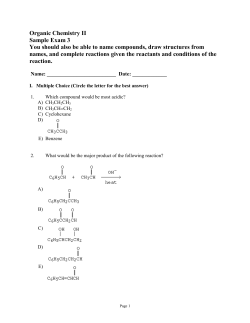
1C Ch 19 Practice Problems
Ch 19 Practice Problems 1. Which metal ion has a d6 electron configuration? A) Mn2+ B) Ni2+ C) Fe3+ D) Co3+ E) Ti2+ 2. Which of the following statements is true about coordination complexes? A) The metal is a Lewis base and the ligands are Lewis acids. B) Only complexes with coordination number 6 are found in nature. C) When the ligands approach a transition metal ion in an octahedral field, the d xz, dyz, and dxy atomic orbitals are affected the least by the ligands. D) None of these is true. E) All of these are true. 3. Which of the following coordination compounds will form a precipitate when treated with an aqueous solution of AgNO3? A) [Cr(NH3)3Cl3] B) [Cr(NH3)6]Cl3 C) Na3[Cr(CN)6] D) Na3[CrCl6] E) all of these 4. Which of the metal ions in the following complex ions has a d5 electron configuration? A) [V(H2O)6]2+ B) [Ni(NH3)6]3+ C) [Co(CN)6]3– D) [Fe(CN)6]3– E) [FeCl6]4– 5. A coordination compound of Cu2+ can be described as Cu(NH3)xSO4 and is known to contain 29.9% NH3. What is the value of x? A) 2 B) 3 C) 4 D) 6 E) none of these 6. _____ isomers and _______ isomers are classes of structural isomers. A) Geometric, optical B) Coordination, geometric C) Linkage, geometric D) Coordination, linkage E) Geometric, linkage 7. Which of the following complexes shows geometric isomerism? A) [Co(NH3)5Cl]SO4 B) [Co(NH3)6]Cl3 C) [Co(NH3)5Cl]Cl2 D) K[Co(NH3)2Cl4] E) Na3[CoCl6] 8. Give the number of geometric isomers for the octahedral compound [Ma 2B2C2], where A, B, and C represent ligands. A) 1 B) 2 C) 3 D) 5 E) none of these 9. For the process Co(NH3)5Cl2+ + Cl– Co(NH3)4Cl2+ + NH3, what would be the ratio of cis to trans isomers in the product? A) 1:1 B) 1:2 C) 1:4 D) 4:1 E) 2:1 10. Fluoride ion ranks low in the spectrochemical series and produces a weak crystal field in complex ions. Based on this information, predict the number of unpaired electrons in [MnF 6]3–. A) 3 B) 1 C) 0 D) 2 E) 4 11. The complex ion [NiF4]2– is tetrahedral. How many unpaired electrons are there in the complex? A) 0 B) 1 C) 2 D) 3 E) 4 12. A metal ion in a high-spin octahedral complex has two more unpaired electrons than the same ion does in a lowspin octahedral complex. Which of the following could the metal ion be? A) Ti2+ B) Cu2+ C) Mn2+ D) Co3+ E) Co2+ 13. For which of the following metal ions would there be no distinction between low spin and high spin in octahedral complexes? A) Cr2+ B) V2+ C) Co3+ D) Mn2+ E) Ni3+ 14. The spectrochemical series is I– < Br– < Cl– < F– < OH– < H2O < NH3 < en < NO2– < CN– Which of the following complexes will absorb visible radiation of the highest energy (shortest wavelength)? A) B) C) D) E) 15. [Co(H2O)6]3+ [Co(I)6]3– [Co(OH)6]3– [Co(en)3]3+ [Co(NH3)6]3+ Which of the following complexes would be diamagnetic (all electrons paired)? A) [Ni(CN)6]4– B) [V(CN)6]3– C) [Co(CN)6]3– D) [Cr(CN)6]3– 16. How many unpaired electrons are found in Zn(H2O)62+? A) 0 B) 1 C) 2 D) 4 E) 5 17. Specify the number of unpaired electrons in CoF63– (weak field). A) 0 B) 1 C) 2 D) 4 E) 5 18. The structural formula for the square planar coordination compound aquatricarbonylplatinum(II) bromide is A) B) C) D) E) [Pt(H2O)3Br]CO [PtH2O(CO)3]Br [PtH2O(CO)3Br]Br [PtH2O(CO)3]Br2 none of these 19. Give the correct name for the compound Na2[Pt(CN)4(NH3)2] A) disodium diamminetetracyanoplatinate(II) B) sodium diamminetetracyanoplatinum(II) C) sodium tetracyanodiammineplatinate(II) D) sodium diamminetetracyanoplatinum(IV) E) sodium diamminetetracyanoplatinate(II) 20. The following compounds were synthesized: [Fe(H2O)6]2+ and [Fe(NH3)6]2+. One is blue and the other is red. Which compound is blue? (spectrochemical series: I– < Br– < Cl– < F– < OH– < H2O < NH3 < en < NO2– < CN–) A) [Fe(H2O)6]2+ B) [Fe(NH3)6]2+ 1. D 15. C 2. C 16. A 3. B 17.D 4.D 5.C 18. D 6.D 19. E 7.D 20. A 8.D 9.D 10.E 11.C 12. E 13.B 14. D
© Copyright 2025









